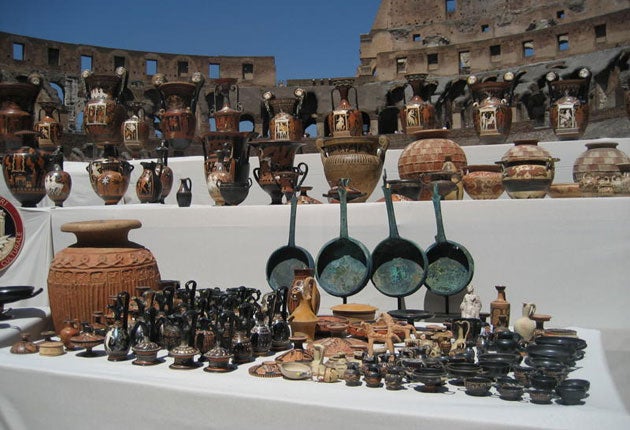Looted antiquities worth millions recovered from black market by Italian police

More than 300 looted antiquities, estimated to be worth more than EUR15 million, were displayed to the press this morning in Rome, having been repatriated to Italy after they were discovered in a warehouse in Switzerland.
It was a scene slightly reminiscent of a Victorian detective novel, in which the robber and his looted candlesticks is unveiled before an impressed gathering of country house guests.
Only today's unveiling took place inside the Colosseum rather than on the pages of a 19th century novel and while there was no criminal present, there was plenty of loot, which consisted of objects such as Etruscan ceramic vases, bronze statues from Sardinia and frescoes from Pompeii – 337 objects in total.
A investigation, code-named Andromeda, led by the carabinieri and the Swiss authorities, discovered about 20,000 artefacts in the free port of Geneva, stored in warehouses that were associated with an unnamed Japanese dealer.
The artefacts were illegally taken from archaeological sites in Lazio, Puglia, Sardinia and the area of Magna Grecia – southern Italy and Sicily. They span a period off 1,200 years, dating from the eighth century BC to the fourth AD.
According to Dr Giuseppe Proietti, superintendent for archaeological heritage in Rome, this is one of the most important recoveries of looted antiquities in recent times. He said: "This is one of the most significant recoveries of our national heritage to this day. We hope to return these artefacts to their original localities so that they can be displayed within their historical contexts."
When the Swiss authorities and the Italian carabinieri began to investigate in 2008, the story developed dramatically in a way that could lead to a sequel of The Medici Conspiracy, a factual book that pieces together the circumstances of the Medici antiquities scandal.
Their attention was initially drawn to the British art dealer Robin Symes, who curated the sale of the Venus of Morgantina to the Getty Museum in Malibù. According to the Italian carabinieri, Symes moved to Switzerland, where his activities were monitored. The Swiss and Italian team then discovered several sham companies, some of which were based in tax havens.
Further inquiries led the authorities to a company administrator in Basle who was involved in managing trafficked archaeological objects for his clients – one of whom was Mr Symes, say the Italian carabinieri.
When the carabinieri searched the administrator's luxurious villa in Basle, they found extensive documentation detailing antiquities that were illegally taken from sites around Italy. The documents indicated that Geneva's free port was used as a clearing centre for the illicitly imported artefacts. In December 2008, nine properties and warehouses were sequestered. This is where the 20,000 archaeological artefacts were discovered.
It took the authorities the whole of 2009 to catalogue the antiquities. The 337 objects repatriated back to Italy have been proved to be from illicit Italian excavations. The majority of the objects remain under Swiss jurisdiction.
From Medici to Italy: Repatriation for Boscoreale Fresco and Corinthian Vase
Subscribe to Independent Premium to bookmark this article
Want to bookmark your favourite articles and stories to read or reference later? Start your Independent Premium subscription today.

Join our commenting forum
Join thought-provoking conversations, follow other Independent readers and see their replies